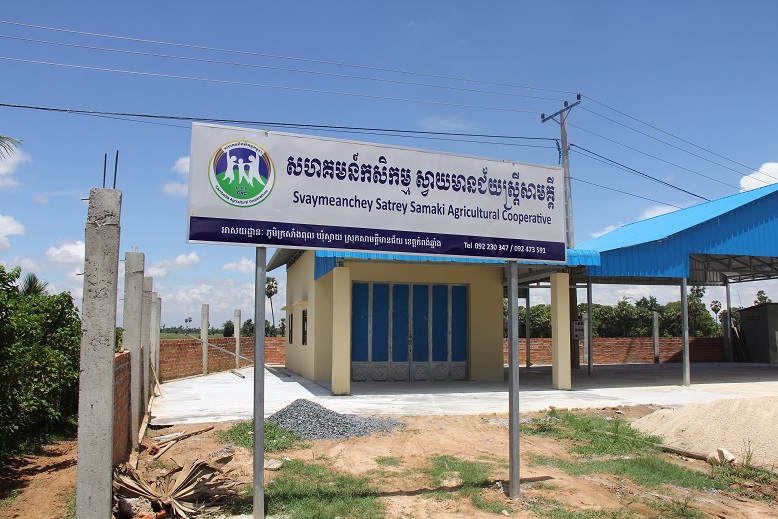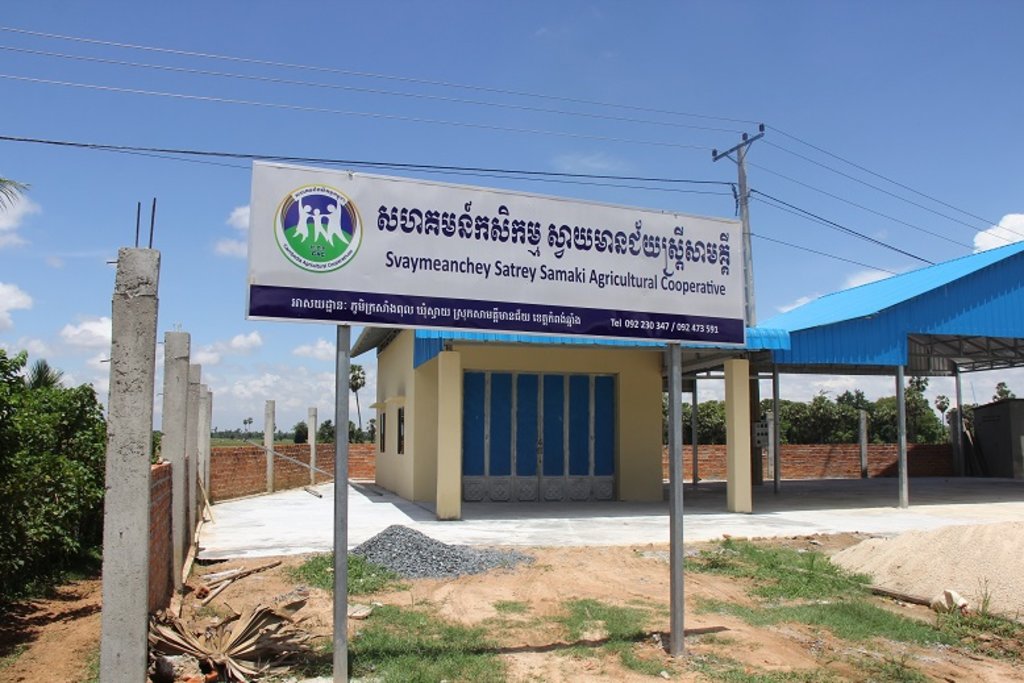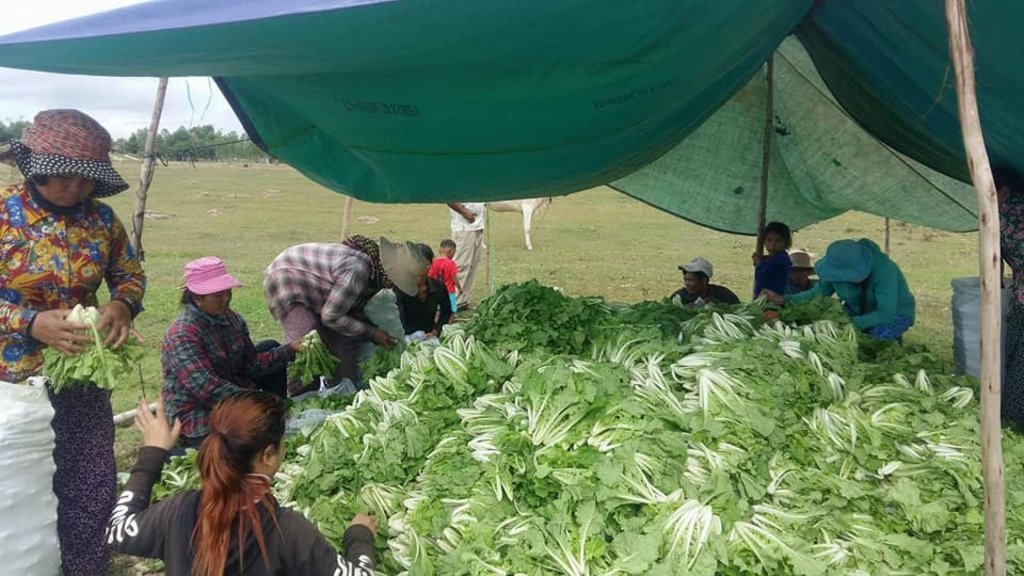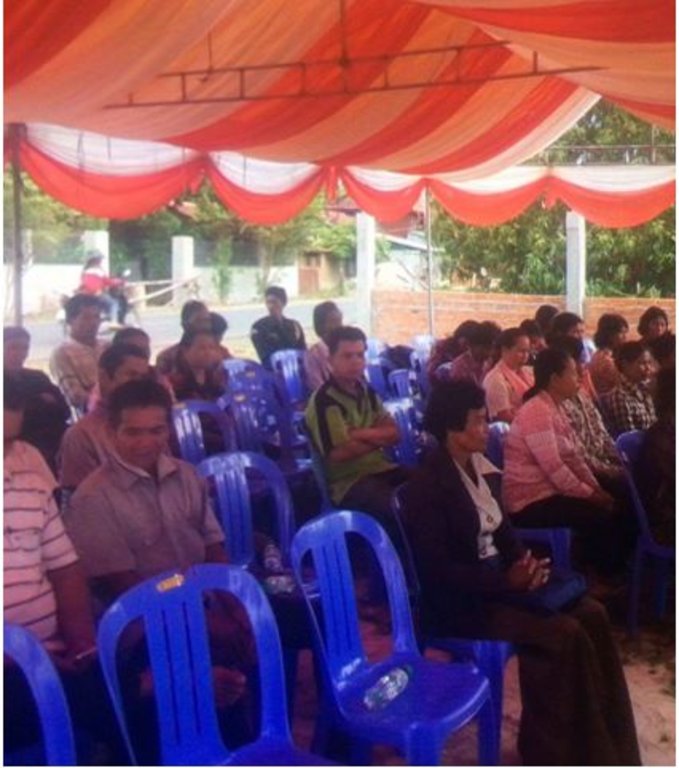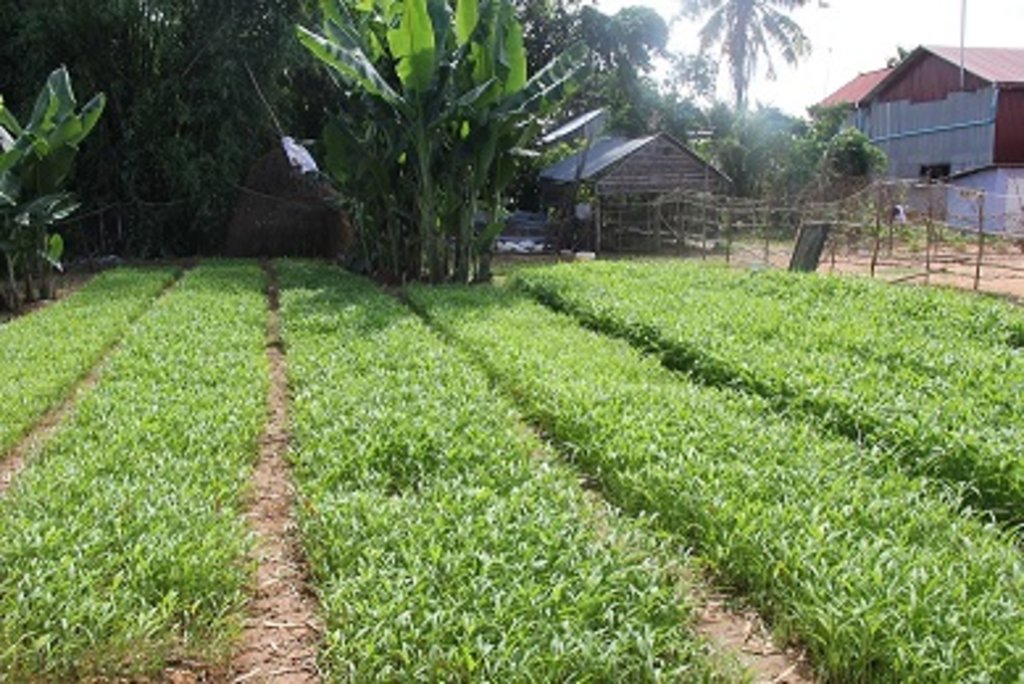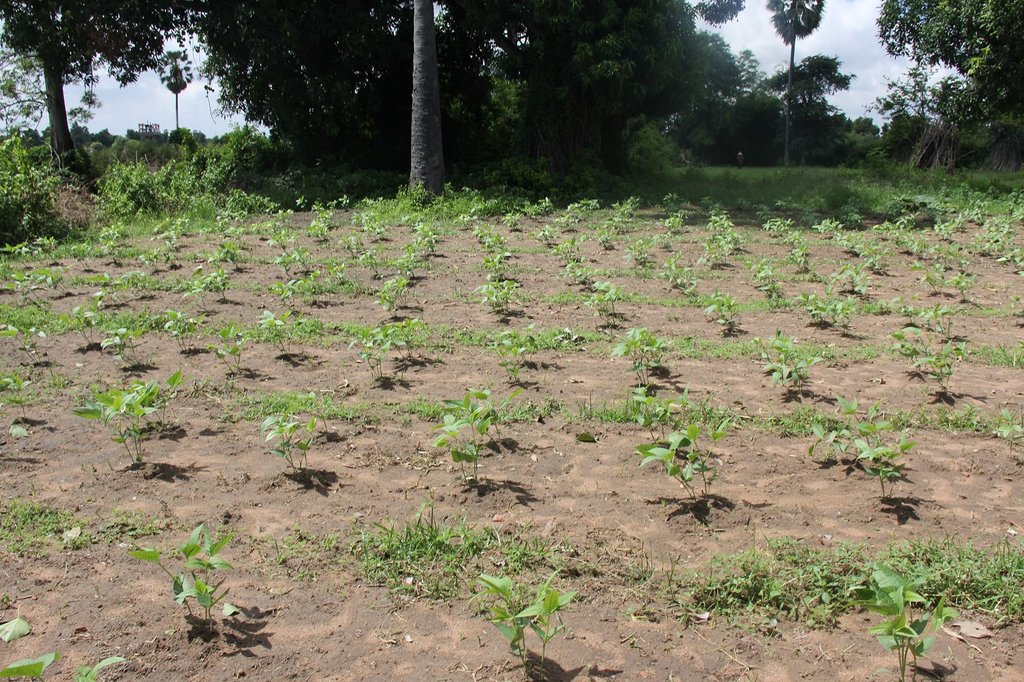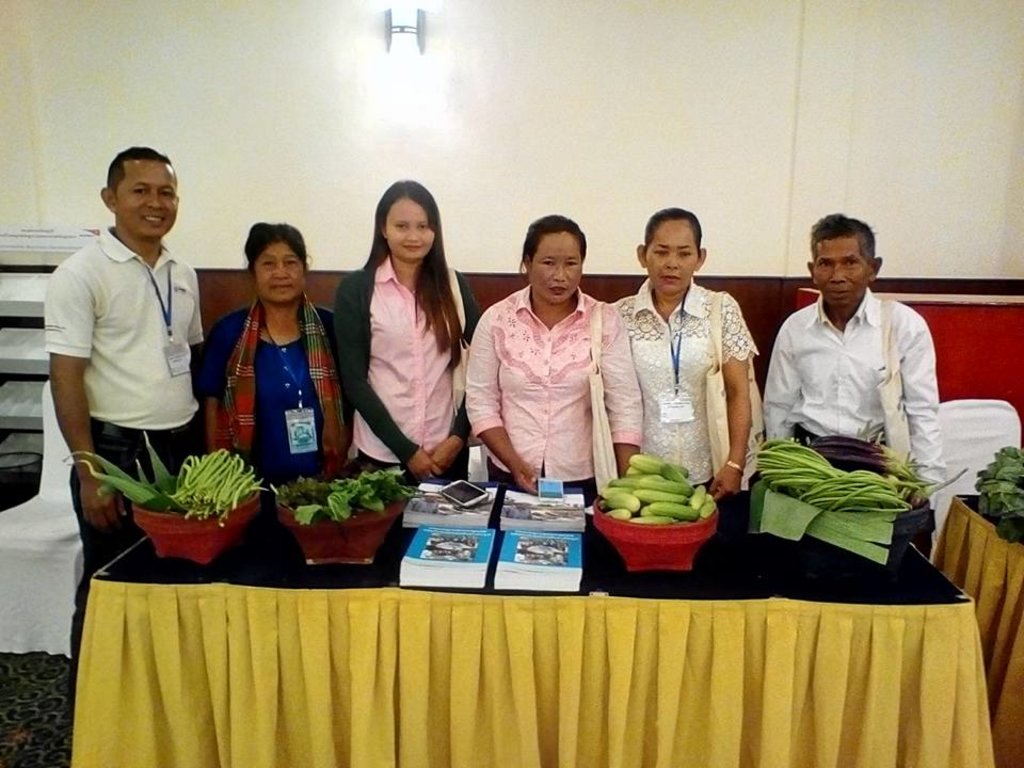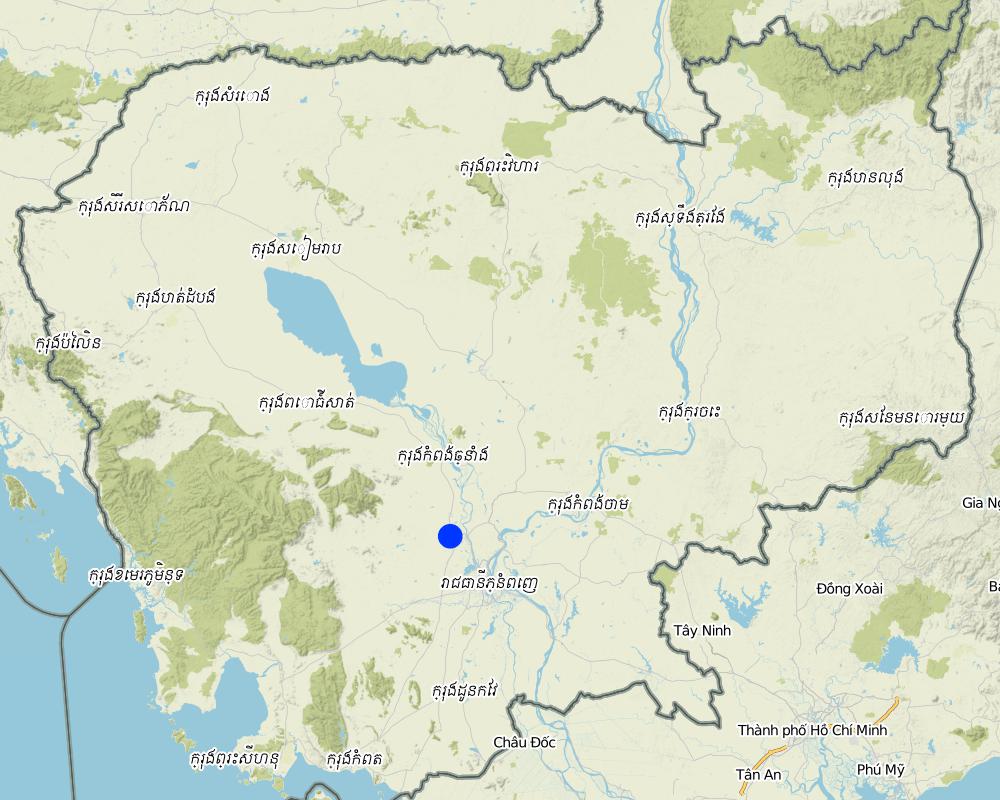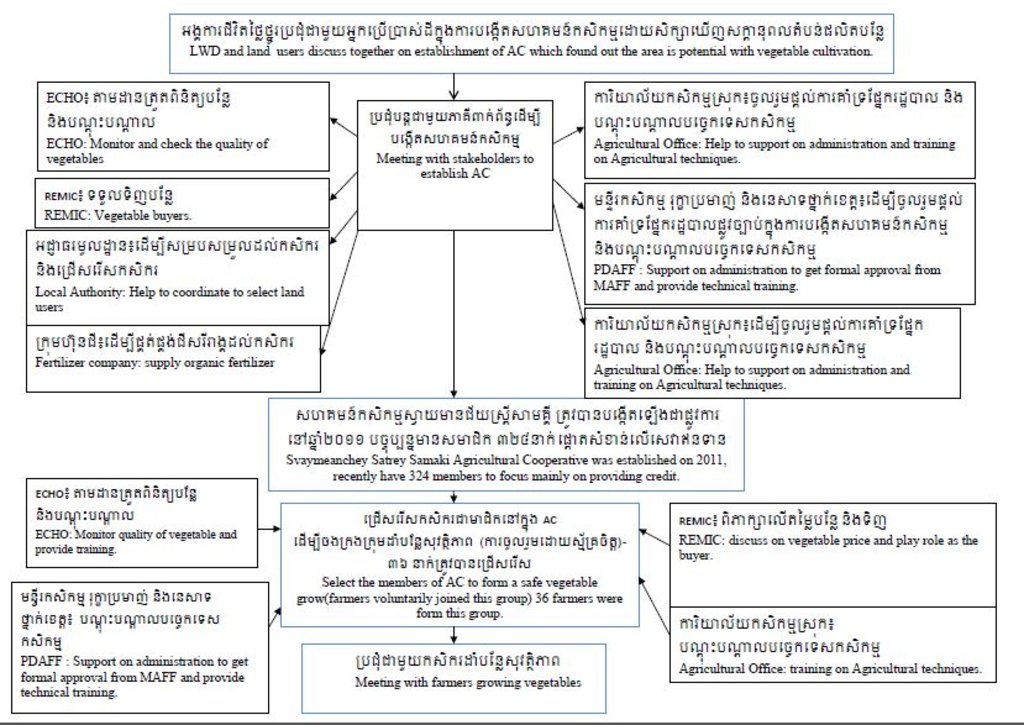A Safe Vegetable Growers Group in the Svaymeanchey Satrey Samaki Agricultural Cooperative [Cambodia]
- Creation:
- Update:
- Compiler: Navin Chea
- Editors: Sophea Tim, Sok Pheak
- Reviewers: SO Than, Nicole Harari
A Safety vegetable Growers Group
approaches_3216 - Cambodia
View sections
Expand all Collapse all1. General information
1.2 Contact details of resource persons and institutions involved in the assessment and documentation of the Approach
Key resource person(s)
Vice Chief of Svaymeanchey Satrey Samaki Agricultural Cooperative:
Him Phally
(+ 855) 16 845352 / (+855) 92 473591
n/a
Svaymeanchey Satrey Samaki Agricultural Cooperative
KrasangPul Village, Svay Commune, Sameakkimeanchey District, Kampong Chhnang Province.
Cambodia
Vice Chief of Agronomy Official at Agricultural Office of Rolea B'ier:
Chhim Bunleang
(+855) 77 797324
chhimbunleang@gmail.com
Agricultural Office of Rolea B'ier district
Prey Puoch village, Chrey Bak commune, Rolea B'ier district, Kampong Chhnange province
Cambodia
Vice Chief of Agricultural Extension Official of Provincial Department of Agriculture, Forestry and Fisheries, Kampong Chhnang Province:
Khim Sombo
(+855) 97 8862 028
khimsombo79@gmail.com
Provincial Department of Agriculture, Forestry and Fisheries, Kampong Chhnang Province.
Ti Muoy Village, Ksam Commune, Kampong Chhang city, Kampong Chhnang province.
Cambodia
Chief of Agricultural Office of Tuek Phos.
Keo Se
(+ 855) 12 64 26 53
keo.se2017@gmail.com
Agricultural Office of Tuek Phos.
Srae Ta Chey, Akphivadth Commune, Tuek Phos District, Kampong Chhnang Province
Cambodia
Name of project which facilitated the documentation/ evaluation of the Approach (if relevant)
Scaling-up SLM practices by smallholder farmers (IFAD)Name of the institution(s) which facilitated the documentation/ evaluation of the Approach (if relevant)
Royal University of Agriculture (RUA) - Cambodia1.3 Conditions regarding the use of data documented through WOCAT
When were the data compiled (in the field)?
25/05/2017
The compiler and key resource person(s) accept the conditions regarding the use of data documented through WOCAT:
Yes
1.4 Reference(s) to Questionnaire(s) on SLM Technologies
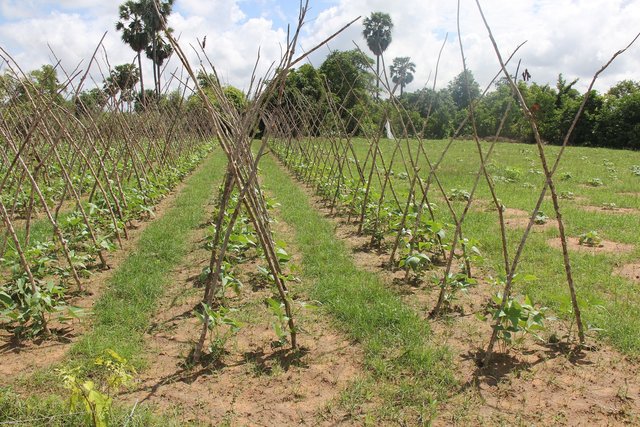
Crop rotation to promote safe vegetables [Cambodia]
Crop rotation is a component of integrated pest management (IPM) which can contribute to an improvement in crop production with a standardized and reduced use of chemical fertilizers and pesticides.
- Compiler: Be Gechkim
2. Description of the SLM Approach
2.1 Short description of the Approach
The safe vegetable growers group was formed by farmers on a voluntary basis and is part of an Agricultural Cooperative. It supports the selling of products through an organized group to buyers. The producers and the buyers have to sign a contract as the main agreement and with set principles. The main principle is to grow vegetables with a standardized application of chemicals and pesticides to ensure the safety of both producers and consumers.
2.2 Detailed description of the Approach
Detailed description of the Approach:
The Svaymeanchey Satrey Samaki Agricultural Cooperative was established in July 2011 under the initiative "life with dignity” (LWD) which also provided financial support and training. In addition, the establishment of the Agricultural Cooperative (AC) was supported by the Provincial Department of Agriculture, Forestry and Fisheries, Kampong Chhnang Province, Cambodia which facilitated administration and provided training to the members of the cooperative. When it was founded, there were 90 members of the cooperative and the focus was solely to access credit. Now, in 2017, the members of the cooperative have increased to 324 and out of these 36 farmers from the Svay Commune have formed the safe vegetable growers group.
The idea of forming this group in April 2016 was based on the fact that the area around Svay Commune has potential for the cultivation of vegetables and most of the farmers do actually already grow vegetables. Noticeably, in Krasang Pul village there are a total of 250 families and out of these 150 families cultivate rice fields and grow vegetables. The safe vegetable growers group received strong support from the life with dignity initiative (LWD) and the Provincial Department of Agriculture, Forestry and Fisheries (PDAFF), Kampong Chhnang province. Furthermore, it also cooperated with Educational Concerns for Haiti Organization (ECHO), which is the International non-government organization which plays a role in controlling the quality of vegetables, and the Rural Entrepreneurship & Market Inclusion in Cambodia (REMIC) which is the buyer of the vegetables. After the formation of safe vegetable group certain leaders of the the Agricultural Cooperative joined a training of trainers programme offered by other stakeholders and were then able to provide training for members of the safe vegetable group as well as those of the Agricultural Cooperative (AC). Through these training sessions they provided new insights in crop cultivation techniques, as well as standardized chemical and pesticide application which were also shared with other stakeholders from organisations such as ECHO, REMIC, and the district Agricultural Office who were also able to contribute their expertise during these sessions.
The main objective of forming the safe vegetable growers groups is to encourage farmers to grow vegetables with a standardized use of chemicals and pesticides so as to be able to meet the market demand, and at the same time ensure the health of both producers and consumers. Additionally, it results in the vegetables having a higher market value and the practice also contributes to sustainable land management. Farmers changed from using chemical fertilizer to using organic and semi-organic fertilizer. This organic fertilizer from the fertilizer company is certified by the Ministry of Agriculture, Forestry and Fisheries to be distributed to the producers. In addition, farmers also apply cow manure as natural fertilizer. The pesticide were used due to the recommendation and guidance from specialists.
The farmers voluntarily joined this group and signed a contract which determined the type of vegetables, the quantity, the quality, the price, as well as the exact time period in which the vegetables should be delivered. The agreement especially specified a standard in the use of chemical fertilizers and pesticides which had to be followed. The REMIC, who is the buyer of the vegetables, distributes the vegetables in its target area including Phnom Penh city. The company only purchases vegetables classed as grade 1, and so for grade 2 and 3 vegetables, the agricultural cooperative has to coordinate with middle men who are operating at several markets. In this respect, safe vegetables can be sold at a higher price, for example safe morning glory can be sold for 1500 Riel per kilogram. If it is sold on other markets, it is sold for 700-800 Riel/Kg for unsafe vegetables or grade 2 and grade 3 vegetables. The amount of vegetables that the company can purchase is limited to only 30 kg of morning glory, 20 kg of bottle gourd, and 50 kg of cucumber as the requests from clients are limited. ECHO plays a role in controlling the quality of the vegetables. They have staff to monitor the vegetables on the farms and also to ensure that the farmers grow their vegetables according to the set standards.
2.3 Photos of the Approach
2.5 Country/ region/ locations where the Approach has been applied
Country:
Cambodia
Region/ State/ Province:
KraSangPul Village, Svay Commune, SameakkiMeanchey District, Kampong Chhnang Province.
Further specification of location:
Potential area of vegetable production.
Map
×2.6 Dates of initiation and termination of the Approach
Indicate year of initiation:
2016
Comments:
This approach hasn't finished yet.
2.7 Type of Approach
- recent local initiative/ innovative
2.8 Main aims/ objectives of the Approach
The main objective of the approach is to encourage farmers to grow safe vegetables so as to be able to gain a high market price and provide safe vegetables.
2.9 Conditions enabling or hindering implementation of the Technology/ Technologies applied under the Approach
availability/ access to financial resources and services
- enabling
Credit/ financial resources are available at the AC for the realization of the safe vegetable group. The AC also has a saving group.
institutional setting
- enabling
Support is provided by the Provincial Department of Agriculture, Forestry and Fisheries, Kampong Chhnang Province and the District Agricultural Office, Sameakki Meanchey.
collaboration/ coordination of actors
- enabling
The existence of LWD, ECHO and REMIC.
- hindering
REMIC is the buyer of safe grade 1 vegetables and is able to determine the amount that is purchased.
legal framework (land tenure, land and water use rights)
- enabling
There are regulations on land rights.
policies
- enabling
Support is provided by the Provincial Department of Agriculture, Forestry and Fisheries (PDAFF), Kampong Chhnang and the District Agricultural Office, Sameakki Meanchey. There are also policies of Ministry of Agriculture, Forestry and Fisheries(MAFF) to promote farmers to grow safe vegetables.
land governance (decision-making, implementation and enforcement)
- enabling
Cooperate with the local authorities.
knowledge about SLM, access to technical support
- enabling
LWD, ECHO, REMIC, MAFF, PDAFF of Kampong Chhnang, District Agricultural Office of Sameakki Meanchey provided training on the standardized use of chemicals and pesticides.
markets (to purchase inputs, sell products) and prices
- enabling
Safe vegetables can be sold at a high price in comparison to other vegetables being sold at the market.
- hindering
REMIC could not buy all the vegetables such as grade 2 and grade 3 vegetables, so the AC is cooperating with middle men at local markets to help farmers.
workload, availability of manpower
- hindering
A lack of labor force.
3. Participation and roles of stakeholders involved
3.1 Stakeholders involved in the Approach and their roles
- local land users/ local communities
Farmers who grow safe vegetables.
Involved in the decision making process in determining the price of vegetables and participated in training.
- SLM specialists/ agricultural advisers
PDAFF, Kampong Chhnang Province, Agricultural Office Sameakki Meanchey, REMIC and ECHO.
Provide training on soil types, access information on vegetables, provide training on the standardized use of chemicals and pesticides.
- researchers
Other NGOs and students.
Collect and compile data on safe vegetable production.
- NGO
LWD
Initiative to establish this agricultural cooperative, provide training and facilitate all activities in the cooperative.
- private sector
Domrey Krahorm Organic Fertilizer Company and Angkor Green Company.
Dissemination of standardized use of chemical fertilizers, provide training on weeding pesticides.
- local government
Local authorities.
Promote the participation of people in the area.
- national government (planners, decision-makers)
Provincial Department of Agriculture, Forestry and Fisheries.
Provide training on agricultural policy.
If several stakeholders were involved, indicate lead agency:
LWD, ECHO, REMIC
3.2 Involvement of local land users/ local communities in the different phases of the Approach
| Involvement of local land users/ local communities | Specify who was involved and describe activities | |
|---|---|---|
| initiation/ motivation | interactive | Safe vegetable producers, local authorities promoted the aim of forming a safe vegetable growers group. They also got support from LWD to realize this group. |
| planning | interactive | Safe vegetable producers, LWD, ECHO, REMIC, PDAFF, DOAFF to cooperate. |
| implementation | interactive | The members of the AC and the vegetable growers group participated in trainings provided by the trainer of AC, Officials from PDAFF, or trainers from LWD or REMIC. The participants join to learn about good agricultural practices and discuss their problems. |
| monitoring/ evaluation | interactive | Safe vegetable producers, LWD, ECHO, REMIC. ECHO, REMIC controlled the farmers’ standardized use of chemical fertilizers and pesticides. They monitor the farms where the land users are growing vegetables. |
3.3 Flow chart (if available)
Description:
Forming a safe vegetable growers group and related stakeholders.
Author:
Ms. Chea Navin
3.4 Decision-making on the selection of SLM Technology/ Technologies
Specify who decided on the selection of the Technology/ Technologies to be implemented:
- mainly land users, supported by SLM specialists
Explain:
Grow not only one type of crops and practices crop rotation, so they can meet market demands.
- Focus on market demand and discuss with producers and buyer.
4. Technical support, capacity building, and knowledge management
4.1 Capacity building/ training
Was training provided to land users/ other stakeholders?
Yes
Specify who was trained:
- land users
- leaders of the Agricultural Cooperative.
Form of training:
- on-the-job
- farmer-to-farmer
- demonstration areas
- public meetings
- courses
Form of training:
- Drawing map.
Subjects covered:
Land management, seed management, water management, chemical fertilizer and pesticides application.
4.2 Advisory service
Do land users have access to an advisory service?
Yes
Specify whether advisory service is provided:
- on land users' fields
- at permanent centres
4.3 Institution strengthening (organizational development)
Have institutions been established or strengthened through the Approach?
- yes, greatly
Specify the level(s) at which institutions have been strengthened or established:
- local
Describe institution, roles and responsibilities, members, etc.
It is just one group in one Agricultural Cooperative in that commune.
Specify type of support:
- financial
- capacity building/ training
- equipment
4.4 Monitoring and evaluation
Is monitoring and evaluation part of the Approach?
Yes
Comments:
Participatory from land user and stakeholders.
If yes, is this documentation intended to be used for monitoring and evaluation?
Yes
4.5 Research
Was research part of the Approach?
Yes
Specify topics:
- economics / marketing
- ecology
- technology
Give further details and indicate who did the research:
Participatory meeting among the farmers and stakeholders to discuss e.g market demands, how the technology farmers practice is positive to the ecology or not etc.
5. Financing and external material support
5.1 Annual budget for the SLM component of the Approach
If precise annual budget is not known, indicate range:
- 10,000-100,000
5.2 Financial/ material support provided to land users
Did land users receive financial/ material support for implementing the Technology/ Technologies?
Yes
If yes, specify type(s) of support, conditions, and provider(s):
Receive seeds and have a buyer of vegetables.
5.3 Subsidies for specific inputs (including labour)
- equipment
| Specify which inputs were subsidised | To which extent | Specify subsidies |
|---|---|---|
| machinery | fully financed | Provide two wheel tractor to use in AC operation. |
| tools | partly financed | Receive vegetable seeds. |
| partly financed | ||
- agricultural
| Specify which inputs were subsidised | To which extent | Specify subsidies |
|---|---|---|
| seeds | Sold with the lower price compared to the price on the market. | |
| fertilizers | partly financed | Sold with the lower price compared to the price on the market. |
If labour by land users was a substantial input, was it:
- voluntary
5.4 Credit
Was credit provided under the Approach for SLM activities?
Yes
Specify credit providers:
The Microfinance provides credit to the Agricultural Cooperative to run their activities, then after AC received credit from microfinance, it provides these credits to the land users. The AC has more opportunities to get credit from microfinance.
Specify credit receivers:
After AC got credit from microfinance it continues to provide credit to AC's members (land users).
5.5 Other incentives or instruments
Were other incentives or instruments used to promote implementation of SLM Technologies?
Yes
If yes, specify:
Grow safety and organic vegetable.
6. Impact analysis and concluding statements
6.1 Impacts of the Approach
Did the Approach empower local land users, improve stakeholder participation?
- No
- Yes, little
- Yes, moderately
- Yes, greatly
Provides the right to participate and encourages farmers to be confident in participating.
Did the Approach enable evidence-based decision-making?
- No
- Yes, little
- Yes, moderately
- Yes, greatly
All the decisions, for example price of product, the quantity, the quality and the cultivation have to be discussed with land users. After becoming member of the safe vegetable group, the vegetables could be sold at ahigher price, reducing use of chemical fertilizer.
Did the Approach help land users to implement and maintain SLM Technologies?
- No
- Yes, little
- Yes, moderately
- Yes, greatly
Promotes farmers to reduce application of chemicals and pesticides base on standardization to get safe vegetable and reduce land degradation.
Did the Approach mobilize/ improve access to financial resources for SLM implementation?
- No
- Yes, little
- Yes, moderately
- Yes, greatly
Loans are provided through microfinance.
Did the Approach improve knowledge and capacities of land users to implement SLM?
- No
- Yes, little
- Yes, moderately
- Yes, greatly
Receive training on the standardized use of chemicals and pesticides.
Did the Approach improve knowledge and capacities of other stakeholders?
- No
- Yes, little
- Yes, moderately
- Yes, greatly
Provides training and shares information between stakeholders.
Did the Approach build/ strengthen institutions, collaboration between stakeholders?
- No
- Yes, little
- Yes, moderately
- Yes, greatly
There is a value chain of the product and cooperation between the producers, buyer and trainers.
Did the Approach mitigate conflicts?
- No
- Yes, little
- Yes, moderately
- Yes, greatly
The safe vegetable group grows the vegetables with the purpose to get a high price if following standards and guidance of cultivation. After the vegetables are cut, the buyer will test whether the vegetables are in grade 1. If they test and vegetables are in grade 2 and 3 they don't buy it. In this case, AC tried to cooperate with local traders or markets to help land user to sell their vegetables which the company does not buy. Land users are not happy if the company does not buy all their vegetables.
Did the Approach empower socially and economically disadvantaged groups?
- No
- Yes, little
- Yes, moderately
- Yes, greatly
The training is provided only to the members of AC.
Did the Approach improve gender equality and empower women and girls?
- No
- Yes, little
- Yes, moderately
- Yes, greatly
Many women participate in the agricultural cooperative (AC) as the leaders of AC and most of the AC's staff are women.
Did the Approach encourage young people/ the next generation of land users to engage in SLM?
- No
- Yes, little
- Yes, moderately
- Yes, greatly
Did the Approach lead to improved food security/ improved nutrition?
- No
- Yes, little
- Yes, moderately
- Yes, greatly
Safe vegetables ensure the health of producers and consumers.
Did the Approach improve access to markets?
- No
- Yes, little
- Yes, moderately
- Yes, greatly
Safe vegetables can be sold at a high price.
Did the Approach improve the capacity of the land users to adapt to climate changes/ extremes and mitigate climate related disasters?
- No
- Yes, little
- Yes, moderately
- Yes, greatly
Practices include crop diversification and crop rotation.
Did the Approach lead to employment, income opportunities?
- No
- Yes, little
- Yes, moderately
- Yes, greatly
Reduces migration, get income.
6.2 Main motivation of land users to implement SLM
- increased production
- increased profit(ability), improved cost-benefit-ratio
- reduced land degradation
- rules and regulations (fines)/ enforcement
- affiliation to movement/ project/ group/ networks
- environmental consciousness
- enhanced SLM knowledge and skills
6.3 Sustainability of Approach activities
Can the land users sustain what has been implemented through the Approach (without external support)?
- yes
If yes, describe how:
By growing safe vegetables farmers get a higher price compared with growing normal vegetables where they use a lot of chemical fertilizer and pesticides.
6.4 Strengths/ advantages of the Approach
| Strengths/ advantages/ opportunities in the land user’s view |
|---|
| Able to grow safe vegetables with a high market price. |
| Able to gain knowledge on sustainable land management through training. The trainings teach them not to use chemical and turn back to use organic and semi-organic fertilizer from the fertilizer company which are certified by Ministry of Agriculture, Forestry and Fisheries. In addition, farmers were also convinced to continue raising cows to get manure as natural fertilizer and make their own organic fertilizer as compost or green manure to reduce the cost of buying organic fertilizer from the company and also promoted to use botanical pesticides, intercropping system, crop rotation ect. |
| Strengths/ advantages/ opportunities in the compiler’s or other key resource person’s view |
|---|
| Able to grow safe vegetables with a good demand and a high market price. |
| Land users participated in planning, training to improve their knowledge. |
| Support from MAFF, PDAFF,District of agricultural office and the local authorities. |
6.5 Weaknesses/ disadvantages of the Approach and ways of overcoming them
| Weaknesses/ disadvantages/ risks in the land user’s view | How can they be overcome? |
|---|---|
| Limiation of market. The REMIC could not buy all vegetables from producers. | Coordinate with middle men to buy the vegetables. |
| Weaknesses/ disadvantages/ risks in the compiler’s or other key resource person’s view | How can they be overcome? |
|---|---|
| REMIC buy only vegetables grade 1, they cannot buy vegetables grade 2 and grade 3, | Find middle men at markets in the region to buy the product. |
7. References and links
7.1 Methods/ sources of information
- field visits, field surveys
At specific location of growing vegetable.
- interviews with land users
Two persons.
- interviews with SLM specialists/ experts
Three persons.
Links and modules
Expand all Collapse allLinks

Crop rotation to promote safe vegetables [Cambodia]
Crop rotation is a component of integrated pest management (IPM) which can contribute to an improvement in crop production with a standardized and reduced use of chemical fertilizers and pesticides.
- Compiler: Be Gechkim
Modules
No modules


